Gerbera Cultivation process
Gerbera is an important commercial cut flower crop. Gerbera flowers have a wide range of colors, including yellow, orange, cream-white, pink, brick red, red color, terracotta, and various other intermediate colors. Sometimes in double varieties, bicolor flowers are beautiful; Gerbera flower stalks are long, thin, and leafy.
In Greenhouse Gerbera cultivated in Soil or Soilless media ( coco peat). Both have their own advantage & limitation.
- Gerbera cultivation cost increase in soilless media is around 30%.
- Production is higher in soilless media compared to soil media.
- Required very close monitoring.
- Soilless media is suitable for a large area of more than 2 Acre.
- In India, mostly soil media is preferred for gerbera cultivation due to electricity & irrigated water quality.
The major Gerbera producing states in India are Maharashtra, Karnataka, Gujarat, Tamilnadu, West Bengal, and Himachal Pradesh.
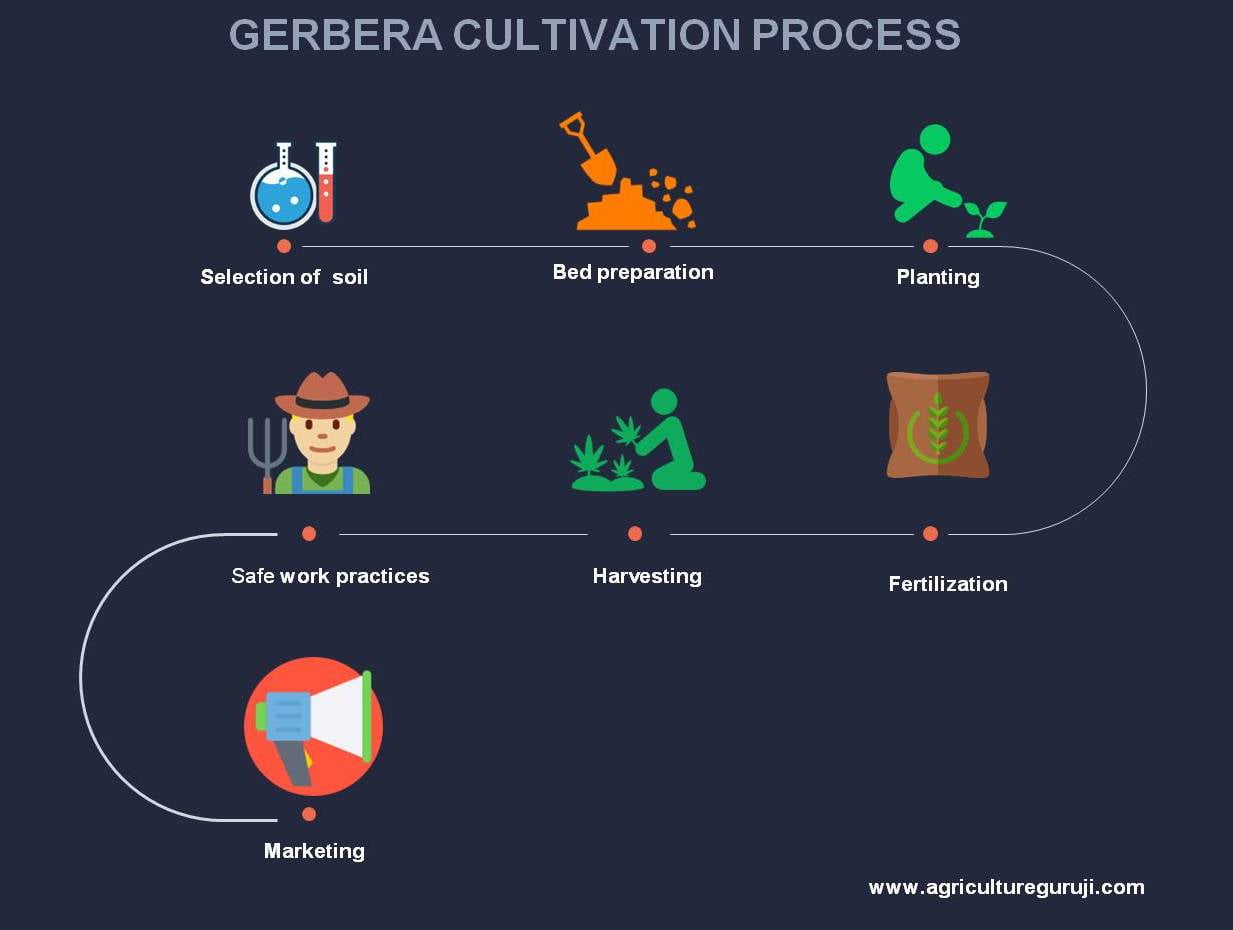
1) Soil Structure Required for Gerbera Cultivation
Two primary factors are considered while selecting soil –
- The soil pH must be between 5.5 to 6.5.
- The soil salinity level does not exceed 1 ms/cm; For better root growth and better penetration of roots, the soil should be highly porous and well-drained.
- Red lateritic soil is the ideal soil for Gerbera cultivation.
Therefore, as soon as you decide on the gerbera cultivation project site, you should analyze the soil as early as.
Soil sterilization
Soil sterilization is required before the gerbera plantation. Fungus Phytophthora is very dangerous for the Gerbera crop.
There are three main soil sterilization methods available,
- Steam: Not practical for Indian conditions.
- Sun: in this method plastic sheet is covered in the soil for 6-8 weeks. The sunrise will heat the soil, and this will kill the most fungus.
- Chemical: this is the most advance & useful method. Hydrogen peroxide (H2O2) with silver is used for the sterilization of soil.
Hydrogen peroxide (H2O2) with silver
Process:
- wet the beds with irrigation water.
- Mix water with hydrogen peroxide at a rate of 35 ml per/lite.
Apply this solution evenly on soil beds. Use one liter of mixed solution ( Hydrogen peroxide (H2O2) with silver + water) For the one-meter area. After that, in 4 to 6 hours, the crop can be planted.
Benefits of Hydrogen Peroxide with Silver:
- Economical, reduce input cost
- Very easy and safe, this method does not affect any dangerous affect human health.
- The plantation can be carried out after 4 to 6 hours of fumigation.
- Eco-friendly and does not produce any phytotoxic effects on plants.
- Almost any fungi, bacteria, and viral presence in the soil destroys the eggs of larva and insects.
Where to buy Hydrogen Peroxide with Silver-
Kumaran Enterprise is the leading manufacturer of hydrogen peroxide with silver.
contact- 9845033066
www.oxipure.co.in

2) Bed preparation process For Gerbera Cultivation
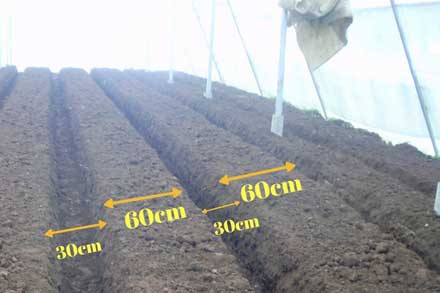
Gerbera plants required well-drained soil, so they grow on raised beds; The dimensions of the bed should be as follows:
- Bed height: 1.5 feet (45 cm)
- Bed width: 2 feet (60 cm)
- Between the beds: 1 foot (30 cm)
If the soil is black cotton, for better drainage, gravel or murum (6 “layer) can be added, and the recommended quantity of soil along with biological composting (FYM) is added.
FYM is Increasing soil texture and giving nutrition gradually to the plant.
Neem cake (@ 1 kg / m) is added in Bed preparation because of the prevention of nematode disease.
All materials must be mixed well.
Bedding material structure:

Basal fertilizer supplements (after bed preparation):
Mix the upper 6 “soil layer well before planting the plants.
| Chemical | Area | Quantity |
| Single Super Phosphate | 20m2 | 5000gm |
| Biozyme Granules | 20m2 | 400gm |
| Humiguard Granules | 20m2 | 400gm |
| Magnesium Sulphate | 20m2 | 1000gm |
3) Planting
Before Gerbera Planting Selecting good gerbera variety is important also colour combinations affect gerbera profit.
For marketing, purpose gerbera grower has the right colour combination in the box. We use this colour combination in our Greenhouse.
| RED | 20% |
| YELLOW | 20% |
| PINK | 20% |
| ORANGE | 20% |
| WHITE | 20% |
In India there is 5- 10 gerbera plant supplier nursery available, Expert gerbera grower selects only a particular variety to form each nursery.
Famous Gerbera variety: Dune, Pre Intenzz, Intense, Winter Queen, Inferno, Cacharelle, Jaffa, Dana Ellen, Sangria, Diana, Imperial, Thalsa, Sonsara, Balance, Paganini, Anneke, Nette, Rosaline, Rosetta, Gloria.
List of top Gerbera plant nursery suppliers
This is India’s top reliable gerbera plant provider company.
Transplanting
When transplanting Gerbera plants, the plant crown should be above 1 – 2 cm soil level without disturbing the root ball.
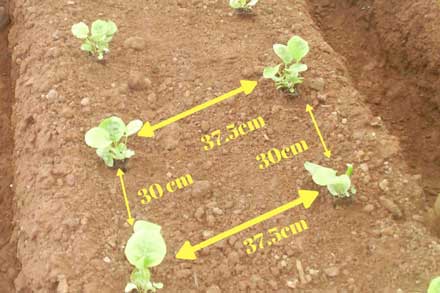
Two rows are planted on one bed, the distance between two rows is 37.5 cm and 30 centimeters between plants in one line, i.e.
- Rows -Rows = 37.5 cm = 1.25 Ft
- Plant – Plant = 30.0 cm = 1′ Ft
4) Fertilization
- Fertigation starts After three weeks on a plantation. Starter grade fertilizer is given For the first three months. Every alternate day Fertilizer dose provides to the plant.
- After 45-50days, the flower bud started to grow, and the cut flower bud (disbudding operation) completes the growth of the plant when 16 to 18 fully developed leaves are seen on the plant stop the flower bud cutting.
- After this, give productive phase fertilizer. In this period, N: P: K2: 1: 4 (e.g., N: P: K 15: 8: 35) @ 0.4 g / Plants give each alternate day to increase volume and quality with EC 1.5 ms/cm.
- For optimum results, irrigation is in small quantities and often fertilized.
- Micronutrients have been given according to the symptoms (e.g., Combi II, Microscope B, Rexolin, Sequel, and Mahabrexil @ 40 grams per 1000 liters of water).
- Analyze soil every 2 to 3 months to decide the specially Nutritious schedule
5) Harvesting:

After 30-45 days of gerbera, the plantation bud initially started, but the initial bud is of inferior quality. Hence this bud should be removed from the base of the flower stalk. This disbudding helps in making the plant strong and healthy. This operation was carried out up to 80 -85 days.
The first flowers are harvested after 12-14 weeks ( 85- 90 days ) after planting. When the stomach 2 – 3 Varlo is fully developing, Flowers are a harvest; It will decide the flower vase’s life.
The good gerbera flower has a stalk length is 45-55cm, and the diameter of the flower is 10 – 12cm.
Morning or evening is the best time for gerbera flower harvesting.
Skilled laborers are required for harvesting. Harvested flowers are kept in a bucket containing clean water. Flowers are very delicate; hence they should be carefully handled
One Garbera plant produces approximately 45 flowers per year.
6) Interculture Operation
Gerbera crop is the perennial crop to get maximum profit from gerbera cultivation. We have performed certain a task to maintain gerbera crop healthily.
Control Pest and Disease in Greenhouse
To control pests & disease, spray pesticides and fungicide & Tonic at the specific time interval (every 2-3 days )
Weeding and raking of soil:
Weeds compete for gerbera plants, take the nutrients, and affect production. Hence, they should be removed. Due to daily irrigation, the gerbera bed surface becomes hard, and hence raking of soil is required. Raking increases soil aeration. Raking should be done twice a month.
Removal of old leaves:
The old, dry, infected leaves should be removed from the plant. It helps in keeping the disease and pest infestation below the economic threshold level.
Read more about the economics of Gerbera.
Disease & Pest
I) Disease
Powdery mildew:
Powdery mildew affects the photosynthesis process of the plant. On the upper leaf surface, a white powder is observed. powdery mildew is seen mostly in the winter season
Crown rot:
The crown of the plant turns black. crown rot is due to Phytophthora cryptogea
Root rot:
Due to root rot, plants drop younger leaves then dead. Root rot is Due to Pythium.
Fungal Complex:
Gerbera Plant become week & show stunted growth.
Alternaria leaf spots:
If moisture remains on the leaf’s surface for a long time, then Black circular spots appear on the leaves.
Botrytis:
Botrytis occurs when the relative humidity of the air is more than 92 %. In botrytis Gray spot seen on the flower
II) pest:
Whitefly:
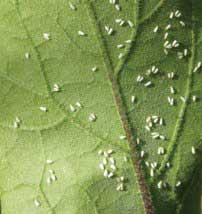
Whitefly is a serious pest in the greenhouse, and you must control whitefly at the initial stage; then, it is difficult to control afterward.
The hot and dry climate is suitable for whitefly growth; whiteflies feed on the lower part of the leaves; a lot of honeydew secrete leads to the development of black Sufi mold on the leaves.
To identify whitefly in the greenhouse/ polyhouse, use yellow sticky traps.
Leaf Miner:
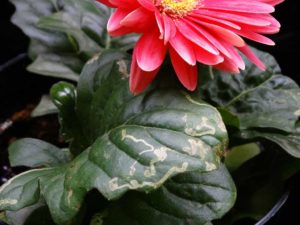
Leaf miner Causes White robes on the leaves. White spiral tunnel in leaves due to larvae, which remain in the soil
Red Mites:
Suck the juice from the lower side of the leaves, which develops brown spots on the leaves’ lower surface, resulting in the drying of the leaves in the margins. Webbing on flower petals
Cyclamen Mites:
Cyclamen mites cause on old leaves are curled up & Young leaves in deformed in shape. Flowers petal’s quality & size will decrease.
Caterpillar:
It creates a spherical hole in the abdominal stomach by eating. In the case of floral attacks, it causes white spots on petals.
Thrips:
Thrips cause straps on a flower petal. The flower size and shape are distorted. Silver-spotted patches on leaves
Snails / Slug:
snails/slug come to eat during the night hours, so snails/slug symptoms are on the leaves and flowers petals through circular feeding holes.
Nematodes:
Due to nematode, plant leaves become Yellow, so stunted growth of the plant. Dirty water in the rainy season, there are favorable conditions for the development and spread of nematodes
Mealybugs :
plant leaves become yellowish & distorted in size
Aphids:
aphids ejaculate some substance on which fungus develops; it is harmful to the gerbera plant.
8) Gerbera Flower Marketing
Gerbera flower demand is high in the marriage season, mostly in January, February, May, August, November & December.
Hyderabad, Mumbai, Delhi, Ahmedabad, Kolkata, Pune, and Banglore are the major markets for the Gerbera flower.




Very nice information Mr.Amar Sawant Sir.
nice information sir
Thank you, Ravi
Hello Sir,
I am Shridhar from Kolhapur and want to start a polyhouse (1000 m2) for Gerbera cultivation. I applied for the subsidy but due to high compitation I was unable to get it .Still I want to start it. Whether it will be right decision? Because I am investing near about 12lakhs. Is there any better option (other than polyhouse) that I can start utilizing same investment.
Hello Shridhar,
if you are very passionate to start greenhouse then start greenhouse farming. there is various agribusiness option available in front of you like mushroom farming, poultry, goat farming.
Hi Sir, is salt water lands suitable for Gerbera cultivation?
Hello Venkata Sivaram Vempati,
salt water land is not suitable for gerbera cultivation.
Hello Sir
I am belonging from RATNAGIRI & I want to start Jarbera flower business . Ratnagiri atmosphere suitable for that ?
Hello sir,
You could grow gerbera in Ratnagiri. If you require any further information, feel free to contact me on [email protected] or WhatsApp 8788462787.
Hello Amar sir, can you guide me as to best region in Karnataka to grow gerbera in polyhouse ?
Hello sir,
We provide our consultancy service all over India. For more details, please contact [email protected] or Call/WhatsApp 8788462787.
Hi Amar,
I am from Pandharpur would like to get in touch with you in regards of Gerbera cultivation project , it would be great if you consult me as i am looking forward to start this as soon as possible
Thank you !
Hello Omkar,
Join our Greenhouse / polyhouse Training cum consultancy program you get complete information on how to start greenhouse farming to marketing. please contact on 8788462787 for more detail about Greenhouse/polyhouse training cum consultancy program.
Hello Amar
I belong to Uttar Pradesh Varanasi Mirzapur Ganga belt Area called Chunar (famous historical place and fort on bank of Ganga)
I m having good enough crop field thinking to start flori work by having green house projects for gerbera flower production.
Can you suggest if soil of this Ganga area is suitable for gerbera . As much I know the soil called Domat soil
If gerbera is not suitable so which commercial flower is suitable for this belt.
We use to grow crops like wheat sugercane peas all vegetables like chilli , tomato pumpkins gram groundnut and others .
Only this area is suitable for rice crop.
So soil is very fertile and water level is 80 feet
Please suggest
Hello Neelu,
please share water, and soil report on 8788462787
Hi Sir,
I need information about the Thrips:and Red Mites and Caterpillar and Whitefly: for 1 Acre . Good fertilizers name needed
My farm near Doddabalpur Near Bangalore
Hello sir, please call us on 8788462787.
Very good.
Hii,
I want to start flower farming on 3 acres of Polyhouse near Mumbai.
How can we connect?
Hello Aniket,
please call us at 8788462787
Can I cultivate gerbera in dahanu dist palghar area
yes
Can I get your phone no
Please share